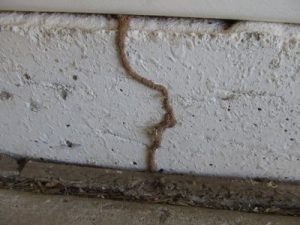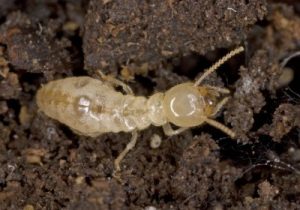
Subterranean termite is a real hidden pest.
The insect leads an extremely secret way of life, which is why sometimes it is very difficult to identify the presence of termites’ colony nest inside your house.
The best way to protect your dwelling is to take preventive measures against these troublesome insects. But there are cases, when the termites’ colony nest reaches enormous size and the evidence of infestation becomes highly visible.
Hide content
- Is It Possible to Recognize the Presence of Subterranean Termites Inside Your House Without the Assistance of a Professional?
- On What Signs One Should Pay a Close Attention During the Inspection?
- What One Should Do If There Are Signs of Infestation Inside or Outside the House?
- Useful articles
- Helpful video
- Conclusion
Is It Possible to Recognize the Presence of Subterranean Termites Inside Your House Without the Assistance of a Professional?
There are ways that will help you to recognize the presence of subterranean termites inside and outside your house, which can be performed by your own.
Recommendation: if you do find the evidence of subterranean termites infestation, it is highly advisable not to resort to the help of do-it-yourself elimination activities. One should immediately contact the local expert on termites, because the consequences of such negligence could be irretrievable.
Though there are obvious signs of infestation, it is desirable to get a professional consultation on this matter.
To recognize the activity of subterranean termites inside and outside your house, you need a good flashlight, screwdriver or pocketknife and coveralls.
First of all, you should pay attention to damp and warm places (basement), the exterior and interior surfaces of the foundation, particularly construction where wood is on or near the soil.
Start your inspection with the basement and use a bright flashlight. Search for mud tunnels and the activity of the swarmers.
You should examine the following areas as well:
- all wood constructions and materials in the basement and inside the hard-to-get-to spaces;
- all sills, sub floors, joists, support posts, supporting piers, basement window frames, wood under porches;
- take close notice on places where one can find concrete flooring: steps, porches, or slabs join the wooden structure;
- any scrap wood on the exterior of your house, old and rotten tree stumps, fence posts and basement windows exterior frames.
On What Signs One Should Pay a Close Attention During the Inspection?
There are various sure signs of subterranean termites infestation that could be find during the inspection of the given areas. The indications are following:
Subterranean termites mud tubes. The most unmistakable sign. The tube provides shelter for the foraging termites, they pass through this tunnel to work and find food and moisture for feeding.
The tubes are flattened and muddy looking. Most subterranean termite tubes are about the width of a pen. They are most evident when they are extending over concrete foundations and other exposed surfaces.
Subterranean termites build four types of tubes (tunnels). Working tubes are built from nests under the ground surface to wooden structures; the termites may travel up concrete surfaces or stone foundations.
Exploratory and migratory tubes arise from the ground surface but do not connect to wood structures. Drop tubes extend from wooden structures back to the soil.
Attention! Mud tubes are a real proof of termite infestation inside the building, but their absence does not certainly mean that your house is free of termites.The termites may reach sills and other wood structures and materials through cracks or voids in the foundation, from earth-filled porches, steps, terraces.
Swarmers. Swarmer is one of the life-stage of a subterranean termite. A “swarm” is a group of adult male and female reproductives that leave their nest to form a new colony.
They are called “flying ants” and are often attracted by the light sources. Most swarmers emerge during the day, most frequently on warm days after rain. The presence of “flying ants” may indicate, that the colony nest is near your dwelling.
Termites frass (droppings). These droppings, also called frass or poop, are wood colored. The frass is just like a saw dust and when contacts the skin it might cause irritation and allergic reactions.
The existence of termite droppings indicates that there is a sound termite activity in the surrounding area. Such droppings can be found on a bed (the sign of “roof” activity), on window sills, carpet, floor.
Piles of wings. The shed wings of swarmers is a true sign that the subterranean termites have entered their next phase of development. You can often found shed wings on the window sills.
Damaged or hollow-sounding wood. While termites lead the veiled way of life and prefer dark and secret places, they can destroy wood material from the inside, at the same time the wood external appearance stays normal.
If wood sounds hollow when tapped, it may be because termites are eating the wood from the inside out. Also, damaged wood when opened looks layered and rotten with a great number of frass.
Advice: When performing a periodical inspection of your house, tap wood materials and structures (including furniture) with a large screwdriver. If the wood sounds hollow-like, it might have been damaged by a troublesome termite pest.
Pattern in the wood. If possible, cut out a little piece of wood structure. Subterranean termites eat and destroy soft wood and eat along the grain.
This causes an evident and highly visible honeycomb pattern inside the wood. It is crucial to stop subterranean termites as soon as the infestation is discovered.
If the wood is absolutely empty and rotten with the termites’ pattern, you will not be able to repair it and the only one possible way is to replace the wood.
Once you see there are parts of the wood that are damaged or completely rotten, you will want to use a chisel to remove these parts. You can fill in damaged parts of wood using a wood filler or hardener.
What One Should Do If There Are Signs of Infestation Inside or Outside the House?
Here you can learn more information about effective treatment method called tenting (fumigation): dangers for termites, preparing for fumigation and cleaning after, how long does this procedure last?
If you face the problem of termites’ colony attack on your house or yard, you better contact the local expert service on termites destruction to get a professional consultation on the spot or over the phone.
In case, there is no possibility to contact a local expert, you can resort to the following termites control measures:
- Combine Tent Fumigation and Subterranean Termite Treatment Drilling with liquid termicides. Fumigation will help you to get rid of flying termites who tend to form a new colony inside your dwelling. The liquid termicide for drilling will slowly but surely kill worker caste of termites that will lead to the death of the queen.
- Combine Soil Treatment with Baits. Soil Treatment with non-repellent termicides will scare the termites away from your house, as well as baits will slowly decrease the population of pests near and under your house.
Be careful! Though modern termidices are water-based and completely safe for the mammals, one should not neglect the simple rules of self-protection. During chemical processing (including liquid and repellent termicides) use protective spectacles, rubber gloves and respirator. Conduct such treatment activities in properly vented premises.
Learn more about subterranean termites: best methods of treatment and DIY methods. Eastern subterranean termites and their tunnels and tubes with photo.Useful articles
If you interested in more information of termites we recommend you to read the following articles:
- All types of termites. Are they harmful to humans? Can they bite you? And what is the difference between drywood and subterranean ones?
- What does swarmers of different species look like: drywood, subterranean, formosan?
- Signs of infestation outside and in the house: in walls or furniture.
- What does termite holes look like? What is droppings and is it toxic to humans? Do termites make noises?
- Posible termite damage, how does it look like? Examples of damage in walls and wood floors.
- All about flying termites: how do they look like, swarming season and what to do if there are swarmers in your house?
- How do they do nests and mounds? How to find it in your garden or inside the house?
- Termite life cycle – from egg to larvae. And social hierarchy: workers, soldiers, queen.
Helpful video
Learn how to protect your home from termites:
Conclusion
The best option is to prevent the appearance of termites in your house, though they are not always possible to detect before it became a real problem.
Use the signs of insects inside your house that were given above for your periodical inspection.
Remember, that there are many accessible and safe methods to destroy termites’ colony today.
But only a specialist from termite control service will help you to choose the best option to get rid of the pests inside your house for a long-time.







